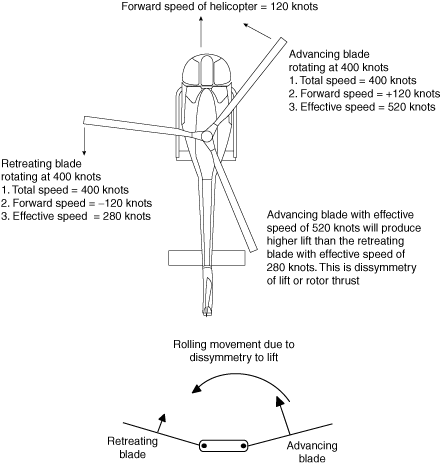dissymmetry of rotor thrust
- dissymmetry of rotor thrust
A condition in which one side of a rotor disc produces more thrust than the other. The speed of relative airflow over the advancing blade is higher than that of the retreating blade. The rotor thrust of the advancing blade also is higher than that of the retreating blade and thus the dissymmetry. This results in the helicopter rolling toward the retreating side. Suitable methods, like decreasing the angle of attack of the advancing blade and increasing the angle of attack of the retreating blade, are used to prevent this rolling tendency. Also called dissymmetry of lift.
View from rear of helicopter.
Aviation dictionary.
2014.
Look at other dictionaries:
Helicopter rotor — This article is about helicopter main rotor systems. For antitorque control, see tail rotor. Helicopter rotor The rotor head of a Sikorsky S 92 A helicopter main rotor or rotor system is a type of fan that is used to generate both the aerodynamic … Wikipedia
helicopter — /hel i kop teuhr, hee li /, n. 1. any of a class of heavier than air craft that are lifted and sustained in the air horizontally by rotating wings or blades turning on vertical axes through power supplied by an engine. v.i. 2. to fly in a… … Universalium
Helicopter — For other uses, see Helicopter (disambiguation). Helicopter An LAPD Bell 206 … Wikipedia
Coaxial rotors — Kamov Ka 32A 12 Coaxial rotors are a pair of helicopter rotors mounted one above the other on concentric shafts, with the same axis of rotation, but that turn in opposite directions (contra rotation). This configuration is a feature of… … Wikipedia
Autogyro — An autogyro is a type of rotorcraft invented by Juan de la Cierva in 1919, making its first successful flight on January 9, 1923 at Cuatro Vientos Airfield in Madrid. [http://www.vectorsite.net/avheli 1.html#m4 Vector Flight] ] Similar to… … Wikipedia
 View from rear of helicopter.
View from rear of helicopter.